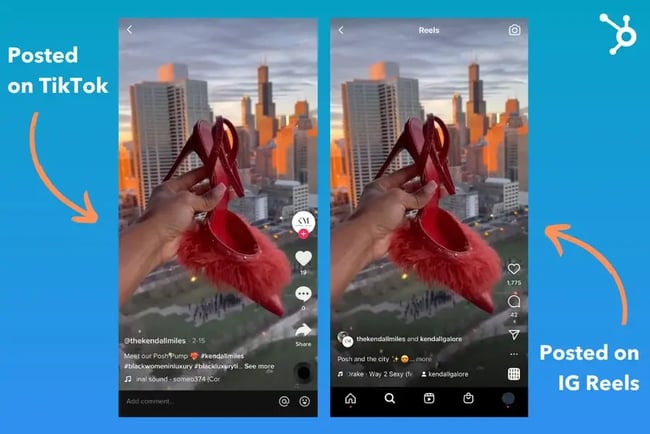Every year, a new digital platform emerges. In the last year alone, Discord, Twitter Spaces, and Twitch have all become very popular with consumers all around this world.

Now, social media marketers are faced with this issue: Should you curate content for each platform and its audience or should you save some time and cross-post on multiple platforms?
In this article, we'll discuss the do's and dont's of cross posting, the benefits of this strategy, and some tools to help you leverage it.
What is cross posting?
Cross-posting is the act of sharing the same content across multiple social media platforms. For example, if you post a video on TikTok, you could post that same video on Instagram and Twitter. It allows social media marketers to save time and focus on strategy and analytics.
Who can get the most out of this strategy?
- Small brands with a limited marketing budget
- New brands that haven’t produced much content
- Social media marketers that want to focus on strategy instead of posting
Benefits and Drawbacks of Cross Posting
Cross posting is a time-saving measure that allows you to share your content with a wider audience without having to put in the extra effort.
The main benefit of cross-posting is that it saves you time. Instead of creating separate pieces of content for each social media platform, you can just share the same content on all of them.
This is especially helpful if you’re short on time or if you’re managing multiple social media accounts.
Another benefit of cross-posting is that it allows you to reach a wider audience. By sharing your content on multiple platforms, you’re increasing the chances that people will see it and engage with it.

While cross posting has many benefits, there are also a few drawbacks to consider.
The first is that not all platforms are created equal. What works on one platform might not work on another.
That’s why many marketers prefer to tailor their content to each platform and its specific audience.
Another drawback of cross posting is that if some users follow you on multiple platforms and see the same content, they may get bored and stop paying attention to what you post.
As with every strategy, you have to be flexible in your approach.
Cross Posting Mistakes
Now that you know what cross posting is and how to do it, let’s take a look at some mistakes you should avoid.
One mistake to avoid is reposting the exact same content on every social media platform. Just because you can cross-post everywhere doesn’t mean you should.
Your followers on each platform are likely to be different, so it’s important to customize your content for each audience. More on that in the next section.
Another mistake I often see on social media is brands posting content featuring watermarks from other platforms.
For instance, when you upload a video to TikTok and save it, the brand’s logo will automatically appear on the video. Instagram recently announced that it would deprioritize videos with the TikTok watermark to avoid recycled content from its competitor.
This practice also compromises your video quality while signaling to audiences that you’re focusing on other social platforms.
Here’s an easy solution: Edit and prep your content on a third-party platform like Canva or iMovie then upload to the respective platform to add additional elements like filters, sounds, and captions.
That will not only keep you from getting shadowbanned but also preserve the quality of your content, as it’s only being uploaded once.
Best Cross Posting Practices
When it comes to cross posting, the most important factor is the quality of your content. This might seem obvious, but it’s important. If your content isn’t good, people won’t want to read it or share it, no matter what platform it’s on.

Once you have great content, the next step is to tailor it to each specific platform. Now you might be thinking, “Is the whole point of cross-posting that I don’t have to tailor content to the platform?” The truth is that while cross posting takes the bulk of the work out, you’ll still have to do some customizing.
This means seeing which platforms deserve which approach. For instance, TikTok and Instagram Reels are both short-form video platforms. This offers an easy cross-posting opportunity.
However, posting a TikTok video on Twitter may not work as well since the latter is mostly text-based. As such, maybe Twitter and Facebook could be a better match-up.
On Facebook, you might want to include a photo or video along with your update whereas you could use the copy only for Twitter.
The key is to make your content engaging and interesting based on audience behavior on each platform.
And finally, to make cross posting easy, consider using software. There are a number of options available, let’s cover that next.
Cross Posting Software
Now that we’ve discussed the benefits of cross posting, you may want to look for tools that will facilitate this process.
First, here are key features you’ll want to look out for:
- Scheduling – The best cross posting software will allow you to schedule your content in advance so you can set it and forget it.
- Customization – As we mentioned before, it’s important to tailor your content for each social media platform. The best cross posting software will allow you to do this with ease.
- Analytics – It’s also key to track the performance of your cross-posted content. You’ll need software with advanced analytics so you can see what’s working and what isn’t.
Let’s take a look at some tools that will help you do it.
Hootsuite

Hootsuite is one of the most popular social media management platforms. It allows you to schedule and publish content, track who’s talking about your brand, and measure your performance.
It also has a feature that lets you cross-post content to multiple social media accounts with just a few clicks.
Buffer

Another tool you can use is Buffer.
Like Hootsuite, Buffer lets you schedule and publish content, track your brand mentions, and measure your performance.
It also has a cross-posting feature that makes it easy to share your content.
Sprout Social

Sprout Social is a third option for those looking for a social media management platform. It has all of the features you’d expect, like the ability to schedule and publish content, track your performance, and engage with your audience.
It also has a cross-posting feature that lets you share content on multiple social media platforms.
When done correctly, cross posting can be an effective way to grow your online presence. Just make sure to avoid the mistakes we discussed and use one of the tools we mentioned to make the process easier.
![→ Free Templates: How to Use YouTube for Business [Download Now]](https://no-cache.hubspot.com/cta/default/53/b33cfd44-133a-49e3-a943-086c5679d485.png)


![Social Media Calendar Template: The 10 Best for Marketers [Free Templates]](https://www.hubspot.com/hubfs/social-media-content-calendar.png)




![How to Post on Snapchat Spotlight [+ Tips for Creating Engaging Content]](https://www.hubspot.com/hubfs/how%20to%20post%20on%20snapchat%20spotlight.jpg)

